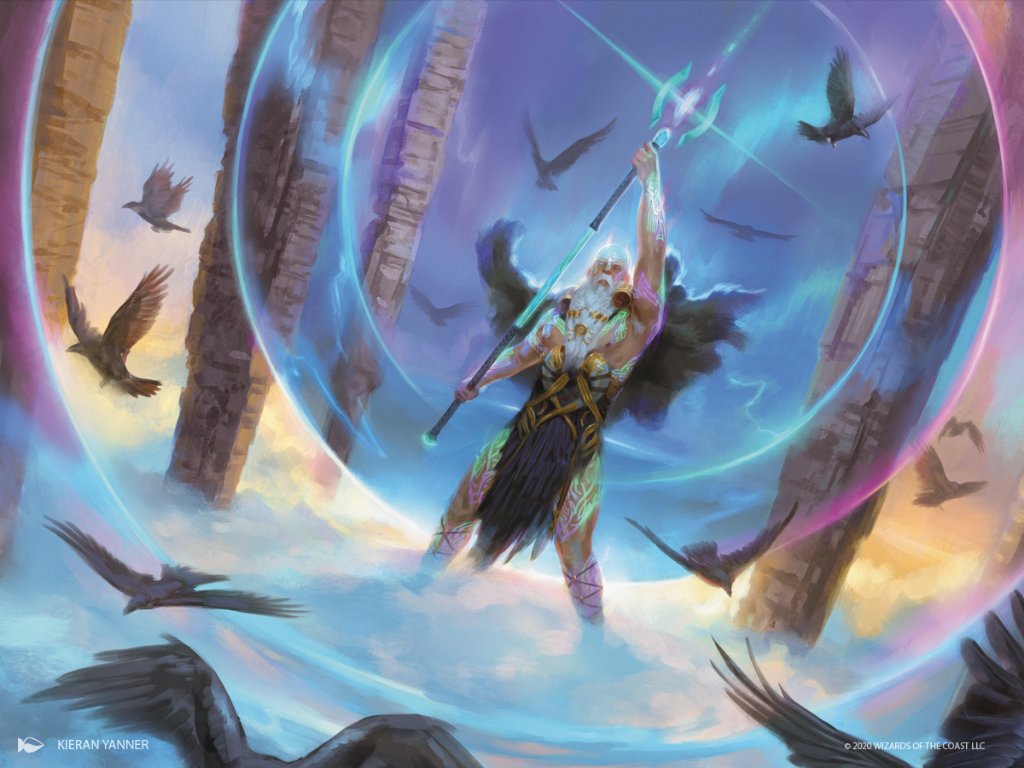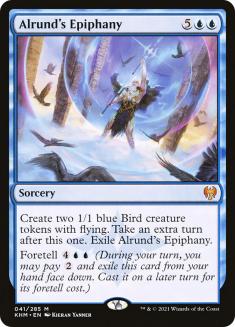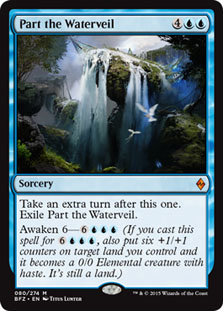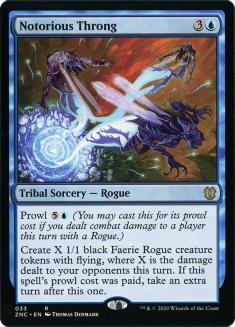Alrund’s Epiphany is a Time Warp with a lot of hidden benefits. We’ve seen plenty of ways to take extra turns over the years, but rarely does one of these cards actually push you towards winning the game. Your other cards are supposed to do that!
Part the Waterveil was one of my favorites from the past with a similar feel, if only because it allowed you to win the game quickly when you started chaining those effects. It also cost a bajillion mana to get going. When it was first printed, no one took it seriously. It looked like a casual card. Then, at some point, people figured out how to abuse it.
Creatures (11)
Lands (24)
Spells (25)
- 4 Explosive Vegetation
- 3 Anticipate
- 1 Sight Beyond Sight
- 3 Send to Sleep
- 4 Nissa's Pilgrimage
- 3 Part the Waterveil
- 1 Nissa's Renewal
- 4 Crush of Tentacles
- 2 Oath of Nissa
Sideboard

Casting Part the Waterveil with awaken felt incredible. Gaining some traction while taking your extra turn is hard to describe. It’s like taking a nap but then sleeping all the way through until the next morning. It’s like feeling refreshed and rejuvenated while hitting the reset button.
In a lot of ways, Alrund’s Epiphany is like Part the Waterveil except it’s a little cheaper. Let’s break it down and figure out just how this card works, what types of decks it could/should go into, and how we can take advantage of the foretell cost.
Foretell 4UU (During your turn, you may pay 2 and exile this card from your hand face down. Cast it on a later turn for its foretell cost.)
Foretell is a new mechanic that allows you to pay for a spell on layaway. Some foretell spells give you a small buff for using the foretell cost, but for the most part it’s going to be a way for you to cast the spell more cheaply on a later turn, but it costs two mana up front. This feels a lot like morph for spells, which can give you a lot of freedom in how you sequence, pay for stuff, and even allow for better timing on some of the splashier effects.
We’re in the latter boat, in that having the upfront part cost two and the foretell cost six means we can get Alrund’s Epiphany at a small discount, just so long as we’re willing to spend two mana somewhere up the line. It’s not exactly cheaper than it would normally be, as we’re technically paying eight mana total, but the upside is that you can occasionally sneak in an Alrund’s Epiphany on a turn where you have six mana instead of seven.
One of the cooler parts of foretell is that finding two mana at some random point in the game shouldn’t be that hard. As we’ve seen with companions, having extra mana lying around on the fifth or sixth turn is pretty common. Additionally, if you’re playing a proactive shell instead of reactive (with counterspells), you’ll be able to spend your mana on your own turn without it hurting too much.
There is an “X”-factor on certain card types that is hard to evaluate. We have many redundant types of cards in Magic, but most of them have their own unique spin. Whether varying in casting costs or tying into a block’s mechanic, Time Warps of all shapes and sizes are not so uncommon (though they are usually mythic). It’s rare that we get a version of this power level, though it seems so innocent on paper. After all, it’s just two Birds, Michael. What could they cost? One mana?
Having any sort of foothold in the game means a foretell version of Alrund’s Epiphany is going to be backbreaking. The Birds themselves can be used as fodder to buy you some time later in the game or potentially in conjunction with some other small or incidental creatures to actually apply pressure. Two Birds aren’t as impactful as the body on Torrential Gearhulk, but it was also kinda hard to make Torrential Gearhulk cast a Time Warp!
Blue decks that have creatures attached to spells always seem a bit weak at first, but then you realize that all it takes to turn a small body into an actual advantage is either time or leverage. Snapcaster Mage might be one of the best cards ever printed, and it basically just adds a 2/1 body onto a spell you’ve cast previously.
The trick, as always, is to make that body count. In a deck featuring a Time Warp effect, making the two 1/1 Bird tokens might be a little difficult, but I can’t imagine it will take more than a day or two for someone to figure out how good this card actually is. Let’s compare it to an old favorite of mine:
This card didn’t see much play when it was legal in Standard, though I can only assume it pops up in Commander from time to time, and I can also wager that the person casting it to take an extra turn is usually winning the game. The “downside” is that you have to play some Rogues, but the payoff is an extra turn full of a ton of small creatures that you can use to pressure planeswalkers, protect your life total, or go for your opponent’s jugular.
In some ways, Alrund’s Epiphany is like Notorious Throng, though without the tribal synergy/payoff. The upside is that we don’t have to play a deck full of creatures, and can instead build our deck full of removal or other elements.
Alrund’s Epiphany feels like it might fit perfectly into some form of ramp shell. Big-mana decks tend to like taking extra turns, after all. The awkward part of Time Warp effects in ramp is that you’re occasionally just spinning your wheels on your free turn. However, the more proactive ramp elements printed in the past few years mean many of your ramp cards will find more stuff for you to do, or potentially be themselves your payoff cards during your Time Warp turns. Imagine having a Uro, Titan of Nature’s Wrath on the battlefield and you cast Alrund’s Epiphany.
Game’s over, dude.

With that said, Uro is not legal in Standard. It is, however, legal in Historic (for some reason). Nissa, Who Shakes the World is also legal in Historic, and a big-mana effect that dumpsters your opponent when given an extra turn sounds just like what the doctor ordered.
Sultai Midrange has been one of the more popular archetypes in Historic as of late, and features a ton of interaction backed by some of the most powerful finishers in the Modern age. The key to making Uro into a powerhouse is interaction of your own. Ramp decks that just play Uro aren’t usually as potent as Sultai or Temur, as those versions tend to kill your opponent’s creatures or counter their spells to buy enough time (and fill the graveyard).
A lot of that has to do with your inability to fill your graveyard without playing a bunch of cheap interaction. In Modern, you get fetchlands, so filling your graveyard is a bit easier. Let’s take a look at some potential builds in various formats and see how they stack up.
Creatures (6)
Planeswalkers (5)
Lands (28)
Spells (21)

There are a few ways to apply extra pressure with a Time Warp effect. The easiest and most powerful “fair” way to do that is with a planeswalker. Ticking up a planeswalker is its own reward, but pushing one tick closer to ultimate or putting your planeswalker out of harm’s way for a turn is nutty, and honestly difficult to correctly evaluate. Creating two blockers to continue protecting your planeswalker is also fantastic!
This iteration of Sultai in Historic is basically just “splashing” for Alrund’s Epiphany, but you’re starting to see the shells in which it can do some serious damage. Taking an extra turn with cards like Uro or Nissa in your deck means you’re going to bury your opponent before they really understand what’s happening (not that they need much help).
The Time Warp effect is starting to rise in popularity in Modern too, partially in response to the legality of Omnath, Locus of Creation and its ridiculous mana generation. Taking an extra turn in a deck featuring Omnath, Locus of Creation just sounds ridiculous. But what about if you add Mystic Sanctuary into the mix? Taking more than one turn in a row when you have Omnath on the battlefield can’t be good for your enemies!
Creatures (7)
Planeswalkers (6)
Lands (29)
Spells (18)

This four-color deck features all the greatest hits of the last two or three years on display running amok in a format where, honestly, they all belong. Modern is the one place where we can go to embrace such degeneracy. If you can combo-kill me on the second turn, Omnath is probably okay.
My first League with this deck using Time Warp instead of Alrund’s Epiphany landed me a 5-0. Time Warp wasn’t a huge factor in most of the wins, but drawing Time Warp always felt absurd. If you pair any of those types of effects with huge bursts of mana or continuous resource generation, you’re going to make out like a bandit. Alrund’s Epiphany costs a little more mana than Time Warp, but those extra tokens might make all the difference in buying you enough time to get full value out of your stuff, dealing with an annoying planeswalker, or just getting in those last few points of damage. You’d be surprised how much pressure you can put on your opponent with Omnath’s damage triggers alone.
As for Standard, I don’t know if Alrund’s Epiphany has a home it can neatly fit into, but it might be fun trying to slot it into Temur Adventures or Azorius Blink. Getting a free untap in a deck playing Dream Trawler and Yorion, Sky Nomad might be pretty rad. It isn’t a permanent to blink, but it feels pretty easy to slot one or two into an 80-card maindeck!
Creatures (13)
Lands (28)
Spells (39)

One thing is true with Yorion above all else: the games go long. With so many lifegain effects and so much card advantage at your disposal, it becomes easy to see why making it to the sixth or seventh turn of the game is pretty simple. Casting Alrund’s Epiphany in any of those scenarios seems beneficial because the Birds are actually pretty sick here. Those two little Birds can do so much in a deck that generates so many small incremental advantages.
Solemn Simulacrum also changes the game here too. Ramping via colorless in a nongreen deck means we’re casting Alrund’s Epiphany on five on occasion thanks to foretell. I also love that a hard-cast Alrund’s Epiphany on seven mana means you’re likely hitting your eighth land on the following turn and activating/casting Yorion from the sideboard. That extra turn might be all you need to get things going!
I expect Alrund’s Epiphany to make waves in multiple formats. It’s powerful, it’s proactive, and it gives you something for an effect that usually takes some work to make good. An expensive spell that grants an extra turn is not likely to make any of these decks. People weren’t champing at the bit to play Nexus of Fate in a normal-ish Sultai Midrange deck. However, when you add in the slightly less expensive version and couple it with the added birds, things start to look a little more appealing.
If I’ve learned anything from Magic over the last few years, it’s that I shouldn’t underestimate a card that does an established thing with a small boost. Giving you two Birds and taking an extra turn for six or seven mana is a powerful spell that will require a lot of time and energy to make perfect, but it’s already good enough on its own. I’m looking forward to trying it out in a number of different decks and formats when it comes out and I hope you are too!







